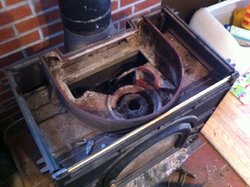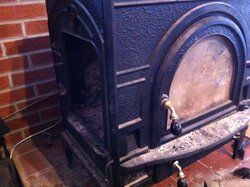Mission complete.
This is not exactly a DIY job. You need some mechanical appitude and tools. You will need one helper.
With our dutchwest I first took the lid off. Next you remove the front of the stove. After unbolting, the front will be tough to pull out as the cement is holding it in place. I had to use some body strength to pull it loose. I used a rubber mallet to tap the sides free. I also carefully used a straight screw driver to pry the pieces apart. Once the side were free, we then removed the inner top, and removed the sides, and last - the inner back.
There is a lot of cleaning and prep work involved for re-assembly. It's a dirty, dusty job. You can take the pieces off and do the cleaning outside to minimize dust in the home. We used a straight screw driver for chiseling the old cement off the pieces. And then we used a 2-inch wire brush on a drill for cleaning the mating surfaces. And last I used compressed air for blowing any dust off the pieces. The most time consuming aspect of the job is cleaning and prepping the pieces.
When executing your disassembly be sure to pay attention to what seams are cemented are what are not.
Before we applied the cement, we did a re-assembly test run, so we would know how it all would play out.
I had to replace my inner top, that's what prompted this project. The re-assembly test run went good, but one thing I did not do was make sure the rod that works the damper fit into the new top. So I suggest that when you do your test run - MAKE SURE EVERYTHING GOES BACK TOGETHER, so your Hercules cement is not improperly curing. I reused my damper rod (as there is nothing wrong with it), but the hole in my new inner top needed drilled a little larger. I did not have a drill bit that large (9/16), so I had to use a grinding disk on a pneumatic grinder and lightly grind down the rod. All this was happening as the cement was already in place. So I suggest you take the time and make sure everything goes back together BEFORE you even open the container of cement.
We used 'Hercules Regular Body High-Heat Furnace Cement', its made by Oatley. The rep at Oatley said it withstands heat up to 2500-degree.
I got a 1/2 gallon pail and only used about 1/3. We applied the cement using a 2-inch putty knife.
I had two other people helping me, so re-assembly was a breeze. We cemented ALL the pieces. Then we installed the inner back. After that, we placed the inner top onto the inner back. One guy held the inner top while the sides were put into place and the inner top was fit into the grooves of the sides. Then we installed the bolts that are on the back that hold the back and sides together.
Next, we installed the front. And did final odds and ends (connect damper, install the combustor, the refractory, etc.) and last we installed the outer lid.
There is no air curing time with the Hercules cement. They want you to cure the cement by getting a small fire stated in the stove as quickly as you can. You need to work fast. The rep told me "The LESS time the cement has to air cure, the better it will work".
I built a small fire, and very gradually allowed the fire to get hotter and hotter and very gradually built it up to the point where I could close the damper. Which is along the lines of what the rep at Oatley said to do.
I installed a NEW inner top. One thing I did not think about is the fumes from the new paint on this top! So be sure to ventilate your home when you do this








 Sounds like you approached it systematically and everything went pretty well. I re-glued some firebox seams in my SIL's 2460 last year, and it seems to have slowed down the amount of air leaking into the stove. It's not leaking as bad as my SIL's but I think I will attempt a complete tear-down on my 2460 next summer. Seems like air is leaking in through the ash pan area (ash door gasket is good,) and I see what appears to be a seam in there. Does it look like it could leak there, from what you saw?
Sounds like you approached it systematically and everything went pretty well. I re-glued some firebox seams in my SIL's 2460 last year, and it seems to have slowed down the amount of air leaking into the stove. It's not leaking as bad as my SIL's but I think I will attempt a complete tear-down on my 2460 next summer. Seems like air is leaking in through the ash pan area (ash door gasket is good,) and I see what appears to be a seam in there. Does it look like it could leak there, from what you saw?